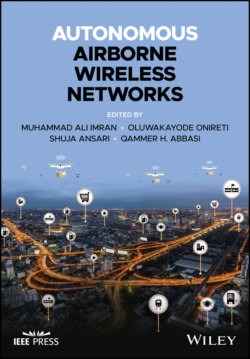Читать книгу Autonomous Airborne Wireless Networks - Группа авторов - Страница 17
2.4.1 Background
ОглавлениеIn wireless communications, several propagation phenomena occur when electromagnetic waves radiate from the transmitter in several directions and interact with the surrounding environment before reaching the receiver. As shown in Figure 2.3, propagation phenomena such as reflection, scattering, diffraction, and penetration occur due to the natural obstacles and buildings, which provoke the multiple realization of the signal transmitted from the UAV, often known as multipath components (MPC). Thus, each component received at the receiver with different amplitude, phase, and delay, and the resultant signal is a superposition of multiple copies of the transmitted signal, which can interfere either constructively or destructively depending on their respective random phases [6]. Typically, several fading mechanisms are added linearly in dB to represent the radio channel as
Figure 2.3 Multipath air‐to‐ground propagation in urban setting.
where is the distance‐dependent path loss, is the large‐scale fading consisting of power variation on a large scale due to the environment, and is the small‐scale fading. Parameters of channel model, such as path loss exponent and LoS probability, are dependent on the altitude level because propagation conditions change at different altitudes. The airspace is often segregated into three propagation echelons or slices as follows:
Terrestrial channel: For suburban and urban environments, altitude is between 10 and 22.5 m, respectively [7]. In this case, the terrestrial channel models can be used to model AG propagation because the airborne UAV is below the rooftop level. As a result, NLoS is the dominant component in the propagation.
Obstructed AG channel: For suburban and urban environments, altitude is 10–40 m and 22.5–100 m, respectively. In this case, LoS probability is higher than that of the terrestrial channels.
High‐altitude AG channel: All channels are in LoS for the altitude ranges between 100 and 300 m or above. Consequently, the propagation is similar to that in the free space case. Moreover, no shadowing is experienced for these channels.
